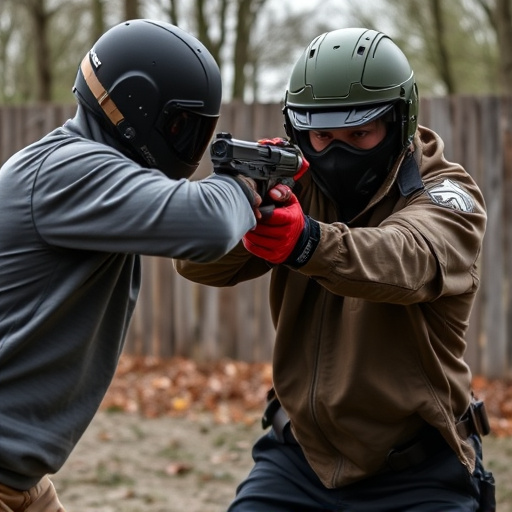Law enforcement agencies globally employ riot control agents like pepper spray for civil unrest, but their use is strictly regulated by legal frameworks prioritizing public safety and individual rights. Accidental or improper exposure requires immediate flushing with water for 15 minutes, removing contaminated clothing, and using neutralizing agents to alleviate discomfort. Proper training in neutralizing pepper spray on the face is crucial for officers managing high-pressure situations, focusing on techniques, protective measures, wind patterns, and strategic deployment to aid de-escalation.
Riot control agents, including pepper spray, are integral tools in law enforcement’s arsenal for managing high-risk situations. However, their usage is governed by stringent legal frameworks to protect citizens’ rights. This article delves into the science behind riot control agents, focusing on pepper spray: its mechanism of action and physiological effects on the human body. It explores best practices for neutralizing pepper spray exposure and emphasizes the importance of comprehensive training and specialized equipment in preparing law enforcement officers for riot control scenarios, ultimately enabling them to effectively manage civil disturbances while minimizing harm.
- Understanding Riot Control Agents: Legal Frameworks
- Pepper Spray: Mechanism & Effects on the Body
- Best Practices for Neutralizing Pepper Spray Exposure
- Training & Equipment: Preparing Law Enforcement for Riots
Understanding Riot Control Agents: Legal Frameworks
Riot control agents, such as pepper spray, are powerful tools employed by law enforcement agencies to manage and disperse crowds during civil unrest or high-tension situations. These chemicals are designed to temporarily disable individuals, providing officers with time to restore order. However, their usage is governed by stringent legal frameworks that vary across jurisdictions.
The application of riot control agents faces ethical considerations, particularly regarding the protection of public safety versus individual rights. In many countries, laws dictate that officers must use these substances as a last resort and proportionately to the threat posed. For instance, when facing an aggressive crowd endangering lives or property, neutralizing pepper spray on the face might be deemed necessary to restore peace. Yet, excessive or unnecessary use can lead to legal repercussions, underscoring the importance of training and adherence to established protocols.
Pepper Spray: Mechanism & Effects on the Body
Pepper spray, a common riot control agent used by law enforcement agencies worldwide, operates by targeting the body’s nervous system. When activated, it releases a fine mist containing capsaicin, the active ingredient found in chili peppers. This substance irritates the eyes and respiratory tract, causing them to become temporarily blurred and painful. The effects can last for several minutes, during which time individuals may experience difficulty breathing, coughing, and reduced visibility.
In case of accidental exposure or misuse, neutralizing pepper spray on the face is crucial. It’s recommended to immediately flush the affected area with copious amounts of water for at least 15 minutes. This action helps to dilute and wash away the capsaicin, alleviating its irritating effects. Additionally, removing any clothing or material contaminated with the spray can prevent further contact with the skin.
Best Practices for Neutralizing Pepper Spray Exposure
When facing pepper spray exposure, law enforcement officers need to employ best practices to quickly and safely neutralize the effects. The primary goal is to minimize pain and maintain clear vision as swiftly as possible. One effective method for neutralizing pepper spray on the face is to flush the eyes and skin with copious amounts of clean water. This should be done immediately upon exposure, ensuring that the water flows over the affected areas for at least 15 minutes.
Additionally, removing any contaminated clothing or accessories is crucial. Gloves should be used to carefully take off items like glasses or hats, as touching contaminated surfaces can lead to further irritation. Once the area is thoroughly wetted and decontaminated, a neutralizing agent like soap can be applied to help break down the pepper spray residues. This process should be repeated for all exposed skin, and officers should seek medical attention if symptoms persist or worsen.
Training & Equipment: Preparing Law Enforcement for Riots
Law enforcement agencies across the globe are increasingly equipped with specialized training and gear to handle riot control, a necessary step to maintain public safety during civil unrest. This preparation involves rigorous scenarios and tactics to manage high-pressure situations effectively. Officers learn how to navigate through crowds, identify agitators, and employ non-lethal weapons such as batons, tear gas, and pepper spray to neutralize threats while minimizing harm.
One critical skill focused on is the safe and efficient neutralization of pepper spray on the face. Training sessions teach officers proper application techniques, including how to ensure their own safety and that of bystanders. This includes understanding wind patterns, wearing protective gear, and knowing exactly when and where to deploy the agent to disrupt rioters’ vision and breathing capabilities, ultimately helping to de-escalate volatile situations.
Riot control agents, such as pepper spray, play a significant role in law enforcement’s ability to manage chaotic situations. Understanding the legal frameworks surrounding these agents is crucial for maintaining public safety and ensuring their responsible use. By grasping the mechanisms and effects of pepper spray, officers can effectively neutralize it on the face and body, minimizing harm and de-escalating tensions. Proper training and equipped with specialized gear, law enforcement agencies can better prepare for riot scenarios, fostering a more secure environment for all involved. Remember, knowing how to safely handle riot control agents is key to navigating these complex situations with professionalism and control.
